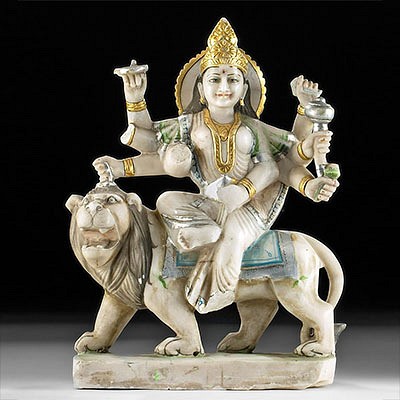Egyptian Faience Ushabti for Prince Khaemwaset TL'd
Lot 1
About Seller
Artemis Gallery
686 S Taylor Ave, Ste 106
Louisville, CO 80027
United States
Selling antiquities, ancient and ethnographic art online since 1993, Artemis Gallery specializes in Classical Antiquities (Egyptian, Greek, Roman, Near Eastern), Asian, Pre-Columbian, African / Tribal / Oceanographic art. Our extensive inventory includes pottery, stone, metal, wood, glass and textil...Read more
Estimate:
$5,000 - $7,500
Absentee vs Live bid
Two ways to bid:
- Leave a max absentee bid and the platform will bid on your behalf up to your maximum bid during the live auction.
- Bid live during the auction and your bids will be submitted real-time to the auctioneer.
Bid Increments
| Price | Bid Increment |
|---|---|
| $0 | $25 |
| $300 | $50 |
| $1,000 | $100 |
| $2,000 | $250 |
| $5,000 | $500 |
| $10,000 | $1,000 |
| $20,000 | $2,500 |
| $50,000 | $5,000 |
| $100,000 | $10,000 |
| $200,000 | $20,000 |
About Auction
By Artemis Gallery
Jul 16, 2020
Set Reminder
2020-07-16 10:00:00
2020-07-16 10:00:00
America/New_York
Bidsquare
Bidsquare : Ancient / Ethnographic Art Through The Ages
https://www.bidsquare.com/auctions/artemis-gallery/ancient-ethnographic-art-through-the-ages-5334
Ancient art from Egypt, Greece, Italy and the Near East, as well as Asian, Fossils, Pre-Columbian, Native American, African / Tribal / Oceanic, Spanish Colonial, Russian Icons, Fine art, much more! Artemis Gallery info@artemisgallery.com
Ancient art from Egypt, Greece, Italy and the Near East, as well as Asian, Fossils, Pre-Columbian, Native American, African / Tribal / Oceanic, Spanish Colonial, Russian Icons, Fine art, much more! Artemis Gallery info@artemisgallery.com
- Lot Description
Ancient Egypt, New Kingdom, 19th Dynasty, reign of Rameses II, ca. 1213 BCE. A stunning faience "overseer" ushabti enveloped in turquoise-hued glaze for Prince Khaemwaset (also Khamweset or Setne Khamwas, literally "he who rises in Thebes"), the fourth son of Ramesses II. The mummiform prince stands erect against an integral back panel while holding a black-painted pick and hoe in crossed arms, with a layered and beaded wesekh pectoral collar painted across the smooth chest, and has a side lock of hair similar to that on depictions of the infant Horus. Sizable almond eyes with elongated canthi peer outwards beneath thick brows and above a slender nose, and a rounded right cheek creates a slight smirk on his face. A column of black hieroglyphs reads, "The Illuminate, the Osiris, Sem Priest of Ptah, Son of the King, (Prince) Khaemwaset" with two back columns reading, "The Illuminate, the Osiris, Sem Priest of Ptah, Son of the King, (Prince) Khaemwaset, he says: O these ushabti, if I am summoned or reckoned to do any work..." Size: 1.625" W x 5.6" H (4.1 cm x 14.2 cm)
Overseers are much more rare than your standard "worker" ushabti as only one overseer would be made for every 10 workers - and would act as a foreman doing labor in the afterlife.
This piece has been tested using thermoluminescence (TL) analysis and has been found to be ancient and of the period stated. A full report will accompany purchase.
Provenance: private East Coast, USA collection; ex-Collection of Professor Sid Port, California, USA,1981
All items legal to buy/sell under U.S. Statute covering cultural patrimony Code 2600, CHAPTER 14, and are guaranteed to be as described or your money back.
A Certificate of Authenticity will accompany all winning bids.
We ship worldwide and handle all shipping in-house for your convenience.
#136209Minor abrasions to body, head, and back panel, with light pitting and a few fissures to glaze commensurate with the kilning process, and light fading to glaze pigment, otherwise intact and excellent. Great remains of pigment and hieroglyphs throughout. TL drill holes atop head and beneath base.Condition
- Shipping Info
-
All shipping is handled in-house for your convenience. Your invoice from Artemis Gallery will include shipping calculation instructions. If in doubt, please inquire BEFORE bidding for estimated shipping costs for individual items.
-
- Buyer's Premium



 EUR
EUR CAD
CAD AUD
AUD GBP
GBP MXN
MXN HKD
HKD CNY
CNY MYR
MYR SEK
SEK SGD
SGD CHF
CHF THB
THB















